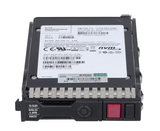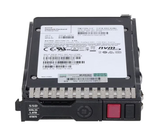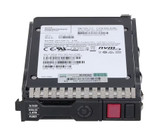Quantum Leap in Storage: The HPE 1.6TB NVMe U.3 PCIe SSD – Fueling ProLiant Gen10’s Cosmic Performance
HPE 1.6TB NVMe U.3 PCIe SSD: A Deep Dive into Mainstream Performance for ProLiant Gen10 Servers
In the ever-evolving landscape of enterprise storage, solid-state drives (SSDs) have become a cornerstone for businesses seeking high performance, reliability, and efficiency. Among the standout options in this domain is the HPE 1.6TB 2.5-inch Small Form Factor (SFF) Digitally Signed Firmware NVMe U.3 PCIe Mainstream Performance SCN Mixed Use Solid State Drive, specifically designed for HPE ProLiant Gen10 servers. This article provides a comprehensive exploration of this SSD, detailing its specifications, features, performance metrics, compatibility, and its value proposition for enterprise workloads.
Overview of the HPE 1.6TB NVMe SSD
The HPE 1.6TB NVMe U.3 PCIe SSD is engineered to meet the demands of modern data centers, offering a balance of capacity, speed, and endurance for mixed-use workloads. It leverages the Non-Volatile Memory Express (NVMe) protocol over a Peripheral Component Interconnect Express (PCIe) interface, delivering superior performance compared to traditional SAS or SATA SSDs. With its 2.5-inch small form factor (SFF) design and integration with HPE's Smart Carrier NVMe (SCN), this drive is tailored for seamless deployment in HPE ProLiant Gen10 servers, a popular choice for enterprise IT environments.
Key Specifications
- Capacity: 1.6 terabytes (TB)
- Form Factor: 2.5-inch Small Form Factor (SFF)
- Interface: NVMe U.3 PCIe (typically PCIe Gen4 x4)
- Workload Type: Mixed Use (MU)
- NAND Flash Type: Triple-Level Cell (TLC)
- Carrier: HPE Smart Carrier NVMe (SCN)
- Connectivity: Single Port
- Height: 15.00 mm (0.60 inches)
- Features: Digitally Signed Firmware (DS)
- Platform Support: HPE ProLiant Rack/Tower/BladeSystem Servers and HPE Synergy
This SSD is hot-swappable, meaning it can be replaced or installed without powering down the server, a critical feature for minimizing downtime in mission-critical environments.
Technical Features and Design
NVMe U.3 PCIe Interface
The NVMe protocol, paired with a PCIe interface, allows this SSD to bypass the bottlenecks of legacy storage interfaces like SATA. The U.3 specification ensures compatibility with a wide range of systems, including those supporting U.2 backplanes in HPE Gen10 servers, while leveraging PCIe’s high bandwidth. Depending on the specific model (e.g., part numbers like P20203-B21 or P20600-001), this drive typically operates on PCIe Gen4 x4, offering theoretical maximum bandwidths of up to 8 GB/s—far exceeding the 6 Gb/s limit of SATA SSDs.
Mixed-Use Workload Optimization
Classified as a "Mixed Use" (MU) SSD, this drive is designed for workloads requiring a balanced mix of read and write operations. It’s ideal for applications such as databases, virtualization, big data analytics, and high-performance computing (HPC), where both random and sequential I/O performance are critical. The use of Triple-Level Cell (TLC) NAND flash strikes a balance between cost, capacity, and endurance, making it a mainstream performance option rather than an ultra-high-endurance write-intensive drive.
Digitally Signed Firmware
Security is a top priority in enterprise storage, and HPE addresses this with its Digitally Signed Firmware (DS). This feature ensures that the drive’s firmware originates from a trusted source, protecting against unauthorized modifications or malicious attacks that could compromise data integrity. This is particularly valuable in environments handling sensitive data, such as financial institutions or healthcare organizations.
HPE Smart Carrier NVMe (SCN)
The inclusion of the HPE Smart Carrier NVMe enhances usability and management. This carrier provides an intuitive interface with LED indicators for drive status, activity, and remote identification. A "do-not-remove" button illuminates to prevent accidental removal during active operations, reducing the risk of data loss. These features streamline maintenance and improve operational reliability in complex server deployments.
Performance Metrics
The HPE 1.6TB NVMe SSD delivers impressive performance tailored to mainstream mixed-use applications. While exact metrics can vary slightly depending on the specific SKU (e.g., P20203-B21 vs. P20755-001), typical performance figures include:
- Endurance:
- Drive Writes Per Day (DWPD): Approximately 3–4 (depending on model)
- 30-Day Writes: Around 8,561–11,512 TB (based on a 3–3.8 DWPD rating over 3 years)
- Sequential Throughput:
- Maximum Read: Up to 5,500–6,200 MiB/s
- Maximum Write: Up to 1,150–2,800 MiB/s
- Random IOPS (4KiB):
- Read (Q=16): 155,000–210,000 IOPS
- Write (Q=16): 87,000–270,000 IOPS
- Maximum Read (Q=256): Up to 700,000–870,000 IOPS
- Maximum Write (Q=32–256): Up to 85,000–275,000 IOPS
- Latency:
- Random Read (4KiB, Q1): 77–105 µs
- Random Write (4KiB, Q1): 24–25 µs
These metrics highlight the SSD’s ability to handle demanding workloads with low latency and high throughput, making it a strong contender for enterprises seeking cost-effective performance without stepping into the premium high-performance tier.
Compatibility with HPE ProLiant Gen10 Servers
The HPE 1.6TB NVMe SSD is purpose-built for HPE ProLiant Gen10 servers, a versatile family of rack, tower, and blade systems designed for scalability and performance. Compatible models include:
- HPE ProLiant DL Series:
DL360 Gen10, DL380 Gen10, DL325 Gen10, DL385 Gen10, and DL560 Gen10
- HPE ProLiant ML Series:
ML350 Gen10
- HPE Synergy:
480 Gen10 Compute Module, 660 Gen10 Compute Block
Its U.3 interface ensures backward compatibility with U.2 backplanes, a common feature in Gen10 servers, while supporting the higher bandwidth of PCIe Gen4 in configurations where available. This flexibility allows IT administrators to deploy the SSD across various chassis types (e.g., 8-bay SFF, 24-bay SFF) without requiring significant hardware upgrades.
Benefits for Enterprise Workloads
Performance Boost
Compared to SATA SSDs, the NVMe U.3 PCIe interface offers significantly higher bandwidth and lower latency, accelerating data transfers and improving application responsiveness. This is particularly beneficial for virtualized environments and transactional databases, where I/O bottlenecks can degrade performance.
Reliability and Endurance
With an endurance rating of 3–4 DWPD, this SSD can sustain moderate write-intensive workloads over its lifespan (typically backed by a 3-year warranty). HPE’s rigorous testing—over 3.35 million hours—ensures reliability, reducing the risk of drive failure in production environments.
Cost-Effectiveness
Positioned as a "mainstream performance" option, this SSD delivers a compelling price-to-performance ratio. It avoids the higher costs of high-performance or write-intensive SSDs while still meeting the needs of most enterprise mixed-use applications.
Simplified Management
The Smart Carrier NVMe and compatibility with HPE management tools (e.g., HPE SmartSSD Wear Gauge) enable administrators to monitor drive health, predict failures, and manage replacements proactively, minimizing downtime.
Use Cases
The HPE 1.6TB NVMe SSD excels in a variety of enterprise scenarios:
- Database Management:
Supports transactional and analytical workloads with balanced read/write performance.
- Virtualization:
Enhances VM density and responsiveness in VMware, Hyper-V, or KVM environments.
- Big Data Analytics:
Accelerates data processing for Hadoop, Spark, or similar frameworks.
- Content Delivery:
Improves caching and delivery speeds for web servers and CDNs.
- General-Purpose Storage:
Serves as a reliable tier for mixed workloads in SMBs or branch offices.
Conclusion
The HPE 1.6TB 2.5-inch SFF Digitally Signed Firmware NVMe U.3 PCIe Mainstream Performance SCN Mixed Use SSD is a robust, versatile storage solution for HPE ProLiant Gen10 servers. Its combination of NVMe performance, mixed-use endurance, and enterprise-grade features like digitally signed firmware and Smart Carrier integration make it an excellent choice for organizations seeking to optimize their data center infrastructure. Whether deployed for virtualization, databases, or analytics, this SSD delivers a balanced blend of speed, reliability, and value, cementing its place as a mainstream performer in the enterprise storage ecosystem.
For IT decision-makers, this drive represents a strategic investment in performance and security without breaking the budget—a testament to HPE’s commitment to delivering practical, high-quality solutions for modern workloads. As of April 9, 2025, it remains a relevant and competitive option in the ever-growing SSD market.
Apr 9th 2025
Recent Posts
-
HPE 1.6TB NVMe U.3 PCIe SSD: Powering ProLiant Gen10 Plus Servers with High Performance and Security
HPE 1.6TB 2.5-Inch SFF NVMe U.3 PCIe Mixed Use SSD for ProLiant Gen10 Plus Servers Introduction …Apr 16th 2025 -
Igniting High-Performance Storage for ProLiant Gen9 & Gen10 Servers: HPE 1.6TB NVMe U.2 SSD
HPE 1.6TB NVMe U.2 SSD: The Turbocharged Heartbeat of ProLiant Performance The HPE 1.6TB 2.5-in …Apr 15th 2025 -
The Turbocharged Heartbeat of ProLiant Performance: HPE 1.6TB NVMe U.2
HPE 1.6TB 2.5-Inch Small Form Factor NVMe U.2 SSD: A Comprehensive Overview for ProLiant Gen8, …Apr 15th 2025




